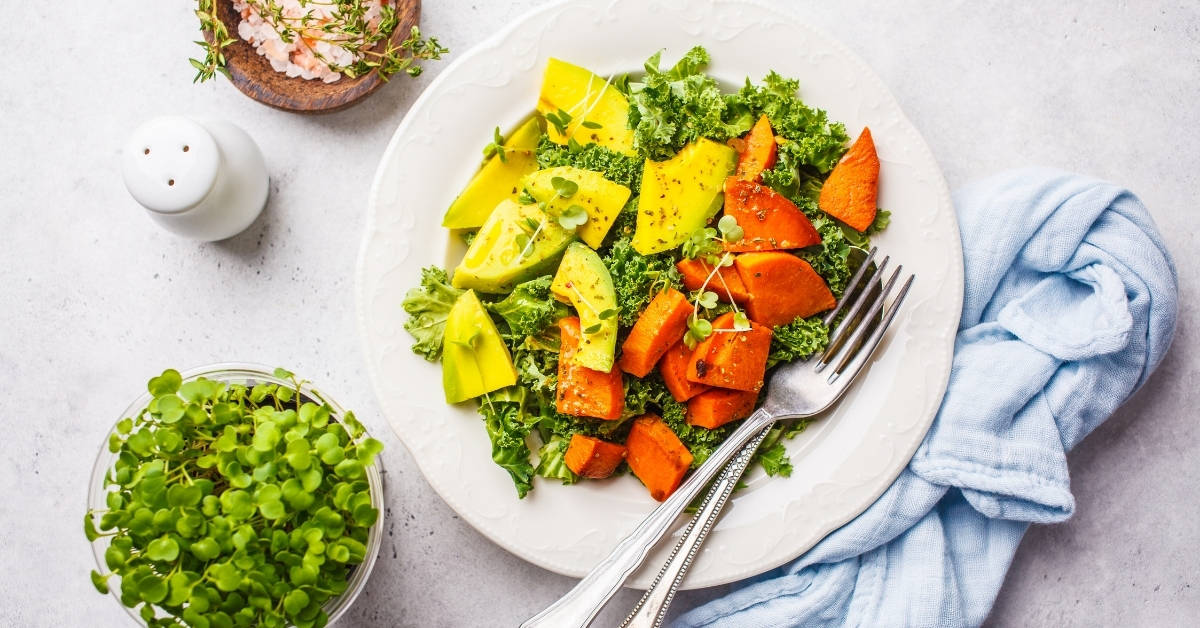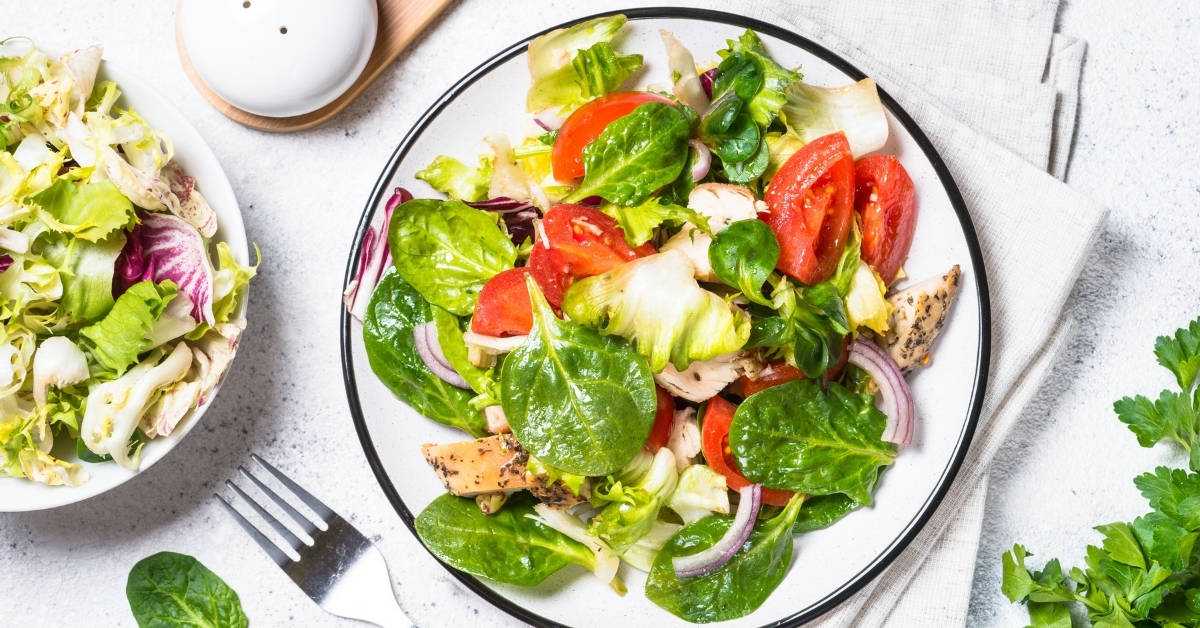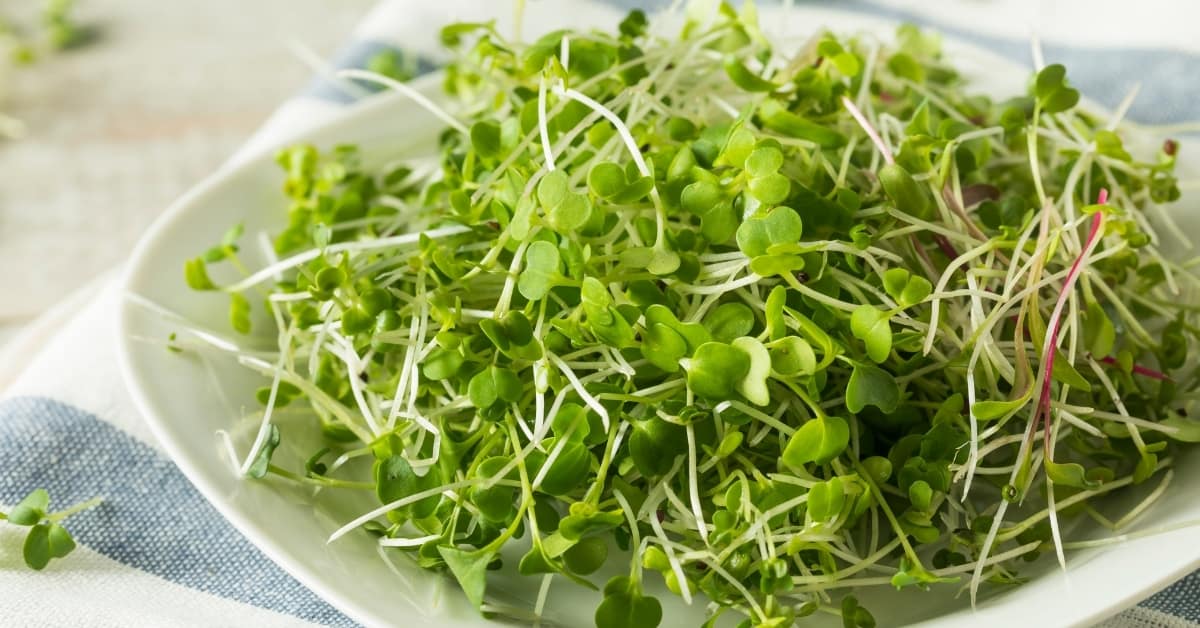This article aims to highlight all of the authentic information you need to know about eating microgreens raw. Let’s start over!
Microgreens are delicious and packed full of flavor and nutrients. From spinach to broccoli to lettuce, all of the different types of microgreens make a delightful addition to your regular meals. These little greens tend to be packed full of flavor and color that can add an excellent taste and aesthetic to any basic meal. Not only that, but microgreens also have the benefit of being incredibly easy to grow yourself in your own home, making them fun and interesting.
Microgreens can be eaten raw. Eating raw microgreens ensures that all of the essential nutrients remain. However, microgreens can have some harmful germs present when eaten raw, so there is a slim chance that they make you sick. Despite this, the chances of becoming ill from raw microgreens are minimal, especially if you thoroughly wash them before consuming them.
Read on to learn about the different types of microgreens, the benefits of eating them, and some of the best ways to add microgreens into your diet. If you are interested in learning more about microgreens, read on to find out everything you need to know about these young, leafy greens.
What Are Microgreens?
Microgreens are a relatively new type of superfood that is becoming more and more popular. They are young greens that are packed full of minerals and nutrients. Microgreens are seeds that have recently germinated and haven’t entirely formed into a vegetable. Microgreens are usually harvested around 7-10 days after the seed has originally germinated.
Microgreens are very popular in fancy restaurants all over the world due to their beautiful looks, delicious taste, and their high level of vitamins. When used for cooking at home, they can transform any ordinary dish into something phenomenal.
A lot of microgreens look quite similar; however, they each have their own unique taste. Some have a mild flavor, some have a sweet flavor, and some have a peppery flavor – each one is unique in its own way, and each one compliments different dishes. Try each different one and find out which ones you like best!
The Different Types of Microgreens
Microgreens can be grown from many different seeds. The most popular varieties of microgreens come from the following seed families:
- Asteraceae family – Chicory, endive, lettuce, and radicchio
- Amaryllidaceae family – Onion, leek, and garlic
- Cucurbitaceae family – Cucumber, squash, and melon
- Brassicaceae family – Broccoli, watercress, arugula, radish, and cauliflower
- Apiaceae family – Carrot, celery, fennel, and dill
- Amaranthaceae family – Quinoa Swiss chard, spinach, amaranth, and beets
Some other things such as wheat, corn, rice, cereals, beans, lentils, chickpeas, and barley can sometimes also be grown into microgreens.
Each type of microgreen varies in flavor from mild to spicy and sweet to bitter. Their flavors are usually considered to be relatively strong, and their appearance is generally described as being very colorful.
Microgreens and Nutrients
Microgreens are incredibly nutritious. The different varieties of microgreens vary in their nutrient contents; however, most of the varieties are rich in iron, zinc, potassium, copper, and magnesium. They are also a great source of antioxidants.

Microgreens benefit from being super concentrated. This means that they contain a higher mineral, vitamin, and antioxidant level than mature greens of the same quantity. They also contain more types of antioxidants and polyphenols than the mature versions.
The Health Benefits of Microgreens
There are so many great benefits to eating vegetables, and the benefits of eating microgreens are even higher.
Eating vegetables is linked to a lower risk of many diseases. This is linked with the high amounts of minerals, vitamins, and antioxidants that they contain.
Microgreens often contain even higher amounts of these nutrients than regular mature vegetables. With this in mind, they can also be known to reduce the risk of certain diseases, including the following:
- Alzheimer’s Disease – Foods that are rich in antioxidants can be linked to lowering the risk of Alzheimer’s disease
- Heart Disease – Due to being so rich in antioxidants, microgreens have been linked to lowering the risk of heart disease.
- Some Cancers – antioxidant-rich vegetables and fruits can lower the risk of some types of cancer. Microgreens are known to have a similar effect.
- Diabetes – Antioxidants found in microgreens can help reduce the type of stress that can prevent sugar from entering the cells correctly.
The nutrients found in microgreens can also help with managing your weight and can also boost your physical and mental wellbeing.
Microgreens Antioxidant Content
Most plant-based foods are very high in minerals, vitamins, and antioxidants. Antioxidants help the body by eliminating unstable waste molecules known as free radicals.
Free radicals are a result of natural bodily processes and environmental factors such as pollution. When these free radicals build-up, this can lead to cell damage, which can eventually result in the development of certain diseases such as cancer.
The body can remove some of the free radicals that exist; however, they can still build up. Antioxidants are best for helping to remove them, and microgreens are filled with these helpful antioxidants.
Microgreens Benefits for Specific Groups
Some research has suggested that microgreens could be beneficial in a tailored way and may provide additional nutrients to specific groups of people.
For example, certain microgreens such as lettuce and chicory are high in vitamins and nutrients but are low in potassium. This could be beneficial to people with kidney disease.
Tailored types of microgreen diets could also be beneficial to people who follow a vegan or vegetarian diet.
The Nutritional Values of Microgreens
The nutritional values of each type of microgreen vary depending on the variety.
A 2012 microgreens study looked into the nutritional content of 25 different varieties of microgreens. The research found that the highest concentrations of vitamins were found in the following microgreens:
- Green daikon radish
- Garnet amaranth
- Red cabbage
- Cilantro
The key benefits of each microgreen varied in the study. For example, red cabbage microgreens were rich in vitamin C but low in vitamin E. On the other hand, green daikon radish microgreens were rich in vitamin E but were relatively low in lutein compared to cilantro, amaranth, and cabbage.

Having a diet that consists of various vegetables and microgreens will supply your body with more of these healthy nutrients and vitamins.
Are There Any Risks with Eating Microgreens?
Microgreens are considered to be generally safe for human consumption. They can be eaten both raw or cooked.
Regardless, there is some risk of food poisoning. However, the potential for bacteria growth on them is relatively small.
Only the leaf and stem of microgreens are to be consumed, and this part is less likely to grow bacteria than the root or seed part.
The sources of contamination on microgreens can include the following:
- The type of microgreens
- The soil or medium in which they have been grown
- The irrigation water
The best course of action is to thoroughly wash your microgreens before consuming them – especially if you have grown and harvested them yourself. Some people prefer to spritz their microgreens with chlorinated water shortly before consuming them to minimize the risks.
The shelf life of microgreens after harvesting is around 10-14 days. Below are some tips on how to reduce the risks:
- Eat your microgreens within ten days.
- Ensure that they have been grown from reputable, safe seeds
- Keep them refrigerated at a maximum of 5 degrees.
- Wash your microgreens with clean water
When properly washed and cared for, microgreens have minimal risk of contamination and are entirely safe to consume.
Can You Eat Microgreens Raw?
Microgreens can be eaten raw; however, only the leaf and stem part should be consumed. The root and seed part is more likely to pick up harmful bacteria. Most bacteria on microgreens are passed on through the soil in which they are grown. By not eating the root and seed part, you cut the risks by half.
For sure, the safest way to kill off possible germs is to cook them well. However, cooking the microgreens can remove some of the healthy nutrients within them. This is why many people choose not to cook their microgreens and, instead, consume them raw.
If you are growing your own microgreens, you want to ensure that you develop the safest microgreens possible. To do this, you want to buy your seeds from reputable seed companies.
Some microgreens are more likely to make you sick if consumed regularly. Below is an explanation of these types of microgreens:
Alfalfa
This is a popular small type of microgreen. It is usually consumed raw in several soups and dishes. However, it is also one of the microgreens with the highest rate of infection after consumption.
Alfalfa microgreens also contain quite a few harmful compounds, as well as the good ones. Some of the harmful compounds found in Alfalfa are saponins (an anti-nutrient), canavanine (an amino acid), and lectins (an anti-nutrient). These natural types of toxins are mostly harmless in lower quantities. However, in larger quantities, that can cause indigestion, diarrhea, inflammation, bloating, and lupus-style symptoms.
Buckwheat
Buckwheat is a quick-growing type of microgreen that contains a compound called fagopyrin. When this compound is eaten in large amounts, it can cause swelling, redness, and a burning sensation to the skin. It can cause the skin to become sensitive to sunlight, and this effect can last for several days.
The symptoms vary from person to person. However, it is best to limit your consumption of buckwheat to avoid any adverse side effects.
Quinoa
Quinoa also contains saponins, which could cause a few adverse side effects. The best way to avoid any negative side effects from quinoa consumption is to fully soak them in water and rinse them thoroughly to clean them before you eat them.
Should You Cook Microgreens?
There are many benefits to cooking microgreens; however, cooking them does remove some of the majorly essential nutrients that they contain.
Cooking your microgreens will help to remove any of the harmful germs that may be present on them. By cooking your microgreens, you will also make them softer and easier to consume. This can be beneficial if you are feeding microgreens to children.
It is not necessary to cook microgreens. You can add a lot of varieties of microgreens to your diet without having to cook them.
How to Add Microgreens to Your Diet?
There are many ways that you can include microgreens into your diet.
They can be added to many dishes and can also easily be used as dressings on wraps, sandwiches, and salads.
They can also be added to smoothie mixes to create unique, nutritious smoothies. Some microgreens can even be juiced for their goodness. Wheatgrass juice is a famous example of a good and healthy microgreen juice.
Microgreens can enhance the flavor, boost the colors, and add texture to several different dishes.
Below are some of the best ways that you can add microgreens to your diet:
- As an alternative to lettuce in things such as tacos, sandwiches, or burgers
- As a garnish for soups, salads, pizzas, or flatbreads
- To add some extra flavor and color to frittatas or omelets.
- To add nutritional value to smoothies or juices.
- As a side dish to any main
Herb varieties of microgreens can also be added to sweet dishes to add some additional flavor. For example, a sprig of mint could be added to a fruit-based mousse or on a fruity variety of dessert to add a different type of flavor.
What are the Most Popular Varieties of Microgreens?
There are a number of different types of microgreens, and each one has its own benefits and fantastic flavor. Below you will find a list of the most popular types of microgreens:
- Basil
- Beets
- Broccoli
- Cabbage
- Carrots
- Celery
- Chives
- Cilantro
- Cress
- Dill
- Fennel
- Kale
- Lemongrass
- Onions
- Parsley
- Radish
- Spinach
- Spring onions
- Sweet pea
All of the above microgreens are great for adding to a number of different dishes to improve them and make them more nutritious.
How to Successfully Grow Your Own Microgreens
Microgreens don’t require a lot of equipment or time to grow successfully, which is why they’re a very popular type of crop for people to grow themselves at home. They can be produced at all times of the year and will grow both indoors and outdoors, making them very convenient.
Below is a guide on how to grow and harvest your own microgreens from your own home:
What Will You Need to Grow Microgreens?
Below is a list of things that you’ll need in order to grow your own microgreens from home:
- Good-quality seeds
- Proper lighting can either be direct sunlight or ultraviolet lighting, ideally for around 12-16 hours each day.
- An excellent place to grow the microgreens such as a container filled with soil or a single-use growing mat that’s designed explicitly for growing microgreens
How Do You Grow the Microgreens?
Below is a list of the steps that need to be taken in order to grow your own microgreens from home successfully:
- Fill your growing container with soil. Make sure you don’t over-compress it, and then lightly water it.
- Sprinkle your choice of seeds on top of the soil. Try to spread them as evenly as possible.
- Lightly mist the seeds with water and then cover up the container with a plastic lid.
- Check on your seeds daily and mist them with a little bit of water each day to keep them moist.
- A few days after the seeds have germinated, you can remove the plastic lid from the container and expose the germinated seeds to the light.
- Water the plants once each day while they’re growing, and you will begin to notice them gaining color.
- After around 7-10 days, your microgreens will then be ready to harvest.
Growing your microgreens at home can be a very rewarding experience. Watching your crops grow and harvesting them yourself can make the experience all the more rewarding when you come to cook them or add them to your favorite dishes.
Final Thoughts
Microgreens are a great addition to any meal and can add a considerable number of vitamins and minerals to your diet. They are a great addition to both sweet and savory meals.
It is generally safe to eat microgreens raw; however, there are a few risks. Despite this, the risks are usually low, and this is why many people do continue to eat microgreens raw. It is thought that the nutritional benefits of eating microgreens outweigh the risks.
Microgreens can be added to your diet as garnishes, side dishes, dressings, and can even be blended up to make great smoothie ingredients or juices. If you are looking for a nutritious, tasty, and colorful addition to your regular diet, raw microgreens are the way to go!

